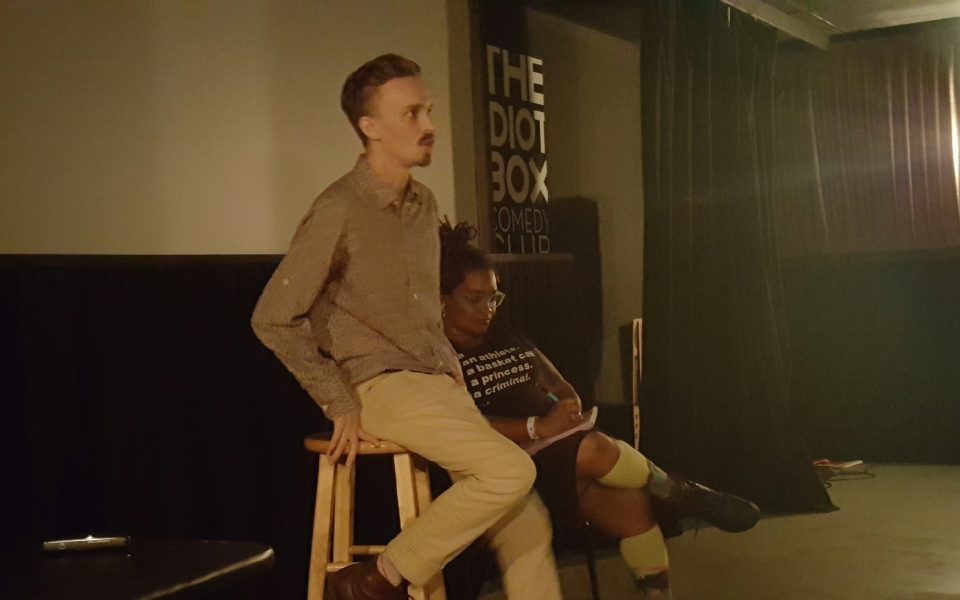If you’re making a movie about a Haitian community in Brooklyn and it’s made by a bunch of white Polish dudes from North Carolina, it’s going to feel disingenuous,” filmmaker Adam Kritzer said. “It can come from a place of generosity, but not from a place of authenticity”.
The day after Thanksgiving — notorious for Christmas shopping and traffic jams — Kritzer nestled into a well-worn couch at Geeksboro in Greensboro to discuss the unique production approach of Good Funk, his independent film about three generations of Afro-Caribbean immigrants in the Red Hook neighborhood of Brooklyn, premiering that evening in the small downstairs movie theater.
“I said this film needs to be made by 50 percent people from this community,” Kritzer said. “This can’t be made by a bunch of outsiders because just statistically having those numbers are going to be super problematic.”
The story of how Good Funk was made is just as interesting as the emotionally gripping narrative that follows a newly single mother struggling with her emotionally challenged child, a couple dealing with the decision of entering parenthood and dealing with aging parents, and elders battling change.
“I realized, even before I started to approach preproduction, was that this was not my story to tell,” Kritzer said. “So, I wanted to be exceedingly careful to create a new model that allowed me to approach it more like a community organizer than strictly a filmmaker. So I lived in the neighborhood for a year.”
By living in the community that he wanted to provide the focus for his movie, he found he could transfer the spirit of its people into his characters more easily.
One scene depicts a mother, Akifah returning home late one evening with her daughter Kolo sleeping in her arms to find that they have been evicted. Shortly after discovering that she is now homeless, Akifah loses her minimum-wage job at a fast food restaurant. Even as a possible solution is presented, she still cannot save her home.
Kritzer told the audience at Geeksboro that the inspiration for the series of hardships came from a woman in Red Hook who was experiencing the same events.
As part of his effort to maintain integrity in his endeavor, Kritzer also created an apprenticeship program during the preproduction phase of the film.
“It was a real symbiotic development between the two things,” Kritzer said. “After the year of working there, I had a really rough draft of a script. I recruited young people in the neighborhood from 18 to 25. They all participated in a six-week film training, visual-literacy program.”
During Kritzer’s year of living in Red Hook, he found that the people he began to connect with were not individuals deeply rooted in the film industry. So when it came time to start work on his film, finding people to add to his team with the needed experience in both film and knowledge of the community was far and in between.
“It became a necessity to say, ‘Okay, if I can’t find people to work with this film in this community who could be my cinematographers the answer isn’t to just scrap and say that I am going to make it with a bunch on NYU grads,” Kritzer said. “The answer, to me, was to create an educational literacy program.”
Kritzer’s program developed during the production of Good Funk. While producing the film, the professionals involved were required to teach the apprentices the skills and techniques required to produce parts of the movie. In turn the work of both the professionals and interns can be seen throughout the final product of the film.
“Why I say it was film training and visual literacy is because, just as much as you get down to the technique and training,” Kritzer said. “We also double back to presentation. Whose story is whose? Who is telling this story? What do you see represented and what do you see an absence of in terms of representation? We are taking these technical skills and abstract concepts and we are working through them and at the end of each week applying them to a script.”
Good Funk is a movie filled with stories within stories. At various intervals, characters deliver monologues that provide a glimpse into their interior lives.
In one scene, a young man named Terence lays on the couch of his father’s empty apartment talking to his ghost. During the conversation, he shares the story of a train ride in which he notices a little boy sitting on a seat while his mother stands near him. When the mother declines Terence’s offer for a seat he pays closer attention to her and notices that she exits the train without her son. Terence feels compelled to care for the child instead of getting help.
As the scene played before the audience at Geeksboro, whispers could be faintly heard. They were later shocked when Kritzer revealed that he experienced the story first hand.
“I’m very immersive,” he said. “You have to get in there. It’s important to know what you know and to know what you can’t speak on and know what is not your place and what you have to defer.”
Join the First Amendment Society, a membership that goes directly to funding TCB‘s newsroom.
We believe that reporting can save the world.
The TCB First Amendment Society recognizes the vital role of a free, unfettered press with a bundling of local experiences designed to build community, and unique engagements with our newsroom that will help you understand, and shape, local journalism’s critical role in uplifting the people in our cities.
All revenue goes directly into the newsroom as reporters’ salaries and freelance commissions.


Leave a Reply